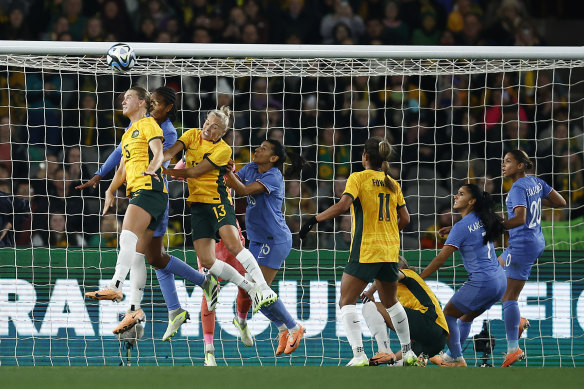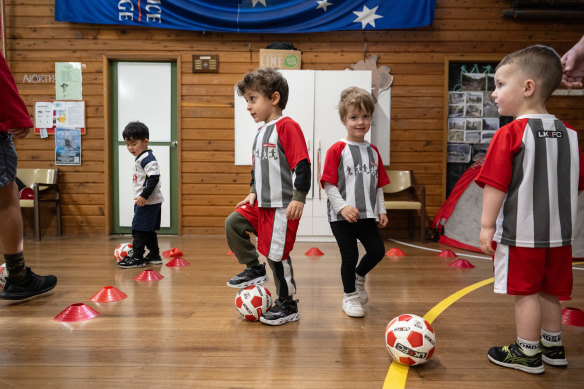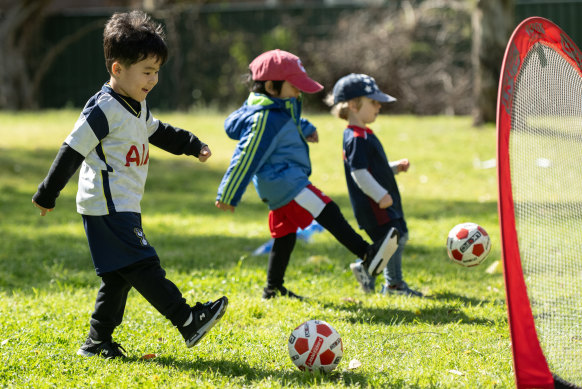This was published 1 year ago
The one thing the Matildas shouldn’t inspire young kids to do
By Mary Ward
A world-leading expert on concussion in soccer has a warning for parents of children inspired by the Matildas, with one of the senior game’s most exciting skills presenting a serious risk for young and inexperienced players.
Children across the country are taking a ball to the backyard or park to imitate the plays of the Australian national team, after the team’s best-ever performance at this year’s home soil FIFA Women’s World Cup.

Australia’s Clare Hunt (left) attempts to head a goal during a pre-World Cup friendly match against France.Credit: Getty
But Dr Kerry Peek, a University of Sydney physiotherapy lecturer and member of Football Australia’s Expert Working Group on Heading and Concussion, said parents should be wary that heading the ball is a skill not usually taught until a child approaches high school age and, even then, with precautions.
“With heading, there are two concerns: there’s the short-term risk of concussion, then there’s also the long-term risks of repeated head collisions,” Peek, who was lead author of a paper recently published in Sport Medicine by the expert group and its European association equivalent, which corroborated research on the subject.
The paper advocated for associations to limit the total number of headers completed by players each week, as well as to seek opportunities to train headers without using a ball.
Sporting organisations are grappling with emerging evidence of the long-term consequences of head injuries, including their relationship with brain diseases such as chronic traumatic encephalopathy (CTE), which has been found post-mortem in a number of athletes.

A Little Kickers soccer training program in Concord on Friday.Credit: Wolter Peeters
Peek said heading was an important part of the game that should not be banned. However, she believed coaching had historically been about “just heading the ball”, rather than learning to track the ball and catch it.
“When we watch [Matildas captain] Sam Kerr she is a master of this. There is a big difference between what she does and just putting your head in the way and letting the ball bounce off,” Peek said, noting poor heading technique could both lead to injury from the ball and increase collisions with other players.
If parents want to assess if their children can safely head a ball, Peek recommends getting a light ball – “a rolled-up ball of newspaper works well” – and telling the child they will throw it at their head, and the child needs to catch it with their hands.
“Kids who can catch that ball with their eyes open may be ready to learn to safely head,” Peek said.
“But if they shy away, or they duck, those kids are not even close to starting to head.”
The English Football Association (FA) has advised children under 12 should not be taught how to head the ball since 2020. It then advocates for a “graduated” approach to introducing the skill, with an under-16s player to be exposed to no more than 10 headers a week, including games and training.
There is no such ban in Australia. Football Australia convened its expert medical group in 2021 in response to the English rule change. It now recommends developing the skill in the under 14 to 17 age groups and using lighter balls when practising.
Football NSW, who has also consulted with Peek on heading safety, has goal kick restrictions for players under 11, including a ban on drop-kicks, which help to keep the ball on the ground.

Preschoolers take part in the Little Kickers soccer training program in Concord on Friday.Credit: Wolter Peeters
“I would like to see some uniformity across Australia,” Peek said.
At Friday morning’s Little Kickers under-fives soccer class at Concord, in Sydney’s inner west, the ball is firmly on the ground as the group of preschoolers learn their first skills of the game.
“At this age, it’s hard enough for them to balance the ball on their feet,” said director Jonathan Woolsey, noting that the program, which takes children to the age of eight refrained from teaching headers at all.
“Heading is something they can start to learn when they head off to start playing for an association.”
The Women’s World Cup has inspired a huge spike in enrolments for junior soccer programs. Before last week’s Matildas semi-final, which drew a record average audience of 7.13 million viewed nationally, Football NSW said sign-ups for junior summer competitions were up 170 per cent on last year.
The Morning Edition newsletter is our guide to the day’s most important and interesting stories, analysis and insights. Sign up here.